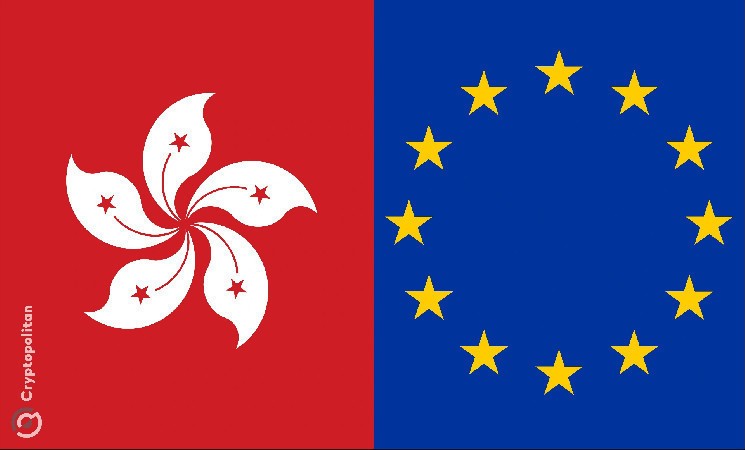Key takeaways from Hong Kong and Europe’s stablecoin legislations

Stablecoins are now a massive part of the crypto industry. You can’t ignore them even if you tried. Over the past four years, stablecoin transactions have skyrocketed, going from $17.4 billion to a mind-blowing $4 trillion.
Right now, the entire inter-currency market was valued at $94.8 billion, and stablecoins took the lion’s share, holding 91.7% of the market. USDT alone is hogging 83.3% of that.
But, despite all this action, stablecoins aren’t exactly living up to their name. They’ve got issues, mainly because they lack the backing of major financial institutions.
Now, with governments in places like Hong Kong and Europe getting their regulatory game on, things are about to change.
I think.
Hong Kong’s play
Let’s start with Hong Kong. These guys aren’t messing around. They’re gunning to be the first in the world to let banks issue stablecoins.
The Hong Kong government’s been pushing hard to set up a regulatory framework that’s all about keeping the financial system in check and making sure consumers don’t get screwed over.
They kicked things off in June with a licensing regime for virtual asset service providers. Now, the Hong Kong Monetary Authority (HKMA) is about to drop some rules for stablecoin issuers.
Hong Kong’s got a pretty tight grip on fiat-backed stablecoin issuers. These issuers must have solid reserves that are fully backed by top-notch. They’ve also got to meet some serious redemption requirements and other regulatory hoops.
Now, who’s jumping into the sandbox? The HKMA has a list of companies, including RD InnoTech Limited, JINGDONG Coinlink Technology Hong Kong Limited, and heavyweights like Standard Chartered Bank (Hong Kong) Limited.
Here’s the deal, though: USDT and USDC, the big boys in the stablecoin world, might have a tough time if they want to operate in Hong Kong. First, they need a physical presence in Hong Kong.
Second, they need to back their reserves with cash in banks, something Europe’s MiCA regulations also demand. And that brings us to our next player: Europe.
Europe’s cards
Europe has released some of the most comprehensive stablecoin regulations we’ve seen, under the MiCA, which the European Parliament passed this year. It’s set to fully kick in by early 2025.
The clock’s already ticking because, from July, issuers have had to start holding real reserves in banks—at least a third of all funds to cover large withdrawals. There are also new rules around transaction limits.
This isn’t sitting well with everyone. Tether’s CEO, Paolo Ardoino, isn’t thrilled. He’s got beef with the idea of keeping large reserves in uninsured bank deposits, which he says exposes them to risks like bank collapses.
According to Paolo, stablecoins should keep their reserves in Treasury bills, which are safer and more stable. But despite his gripes, Tether isn’t pulling out just yet—they’re still talking to the powers that be.
Meanwhile, some exchanges in Europe are already cutting ties with stablecoins that don’t play by the rules. OKX, for example, dropped USDT for its EU users back in March.
Circle’s USDC, on the other hand, is playing the long game, sticking to the regulations and gaining favor. Kraken, however, still lists USDT in Europe, knowing how much customers rely on it.
Here’s what could happen. Circle’s USDC might end up being the big winner in Europe. With MiCA backing it, USDC could surpass USDT in market share and become the top stablecoin in Europe.



 Bitcoin
Bitcoin  Ethereum
Ethereum  Tether
Tether  Dogecoin
Dogecoin  USDC
USDC  Cardano
Cardano  TRON
TRON  Chainlink
Chainlink  Stellar
Stellar  Hedera
Hedera  Bitcoin Cash
Bitcoin Cash  LEO Token
LEO Token  Litecoin
Litecoin  Cronos
Cronos  Ethereum Classic
Ethereum Classic  Monero
Monero  Dai
Dai  Algorand
Algorand  OKB
OKB  Cosmos Hub
Cosmos Hub  Stacks
Stacks  Theta Network
Theta Network  Gate
Gate  Maker
Maker  Tezos
Tezos  KuCoin
KuCoin  IOTA
IOTA  NEO
NEO  Zcash
Zcash  Polygon
Polygon  Synthetix Network
Synthetix Network  Tether Gold
Tether Gold  TrueUSD
TrueUSD  Dash
Dash  Holo
Holo  Zilliqa
Zilliqa  Enjin Coin
Enjin Coin  0x Protocol
0x Protocol  Qtum
Qtum  Basic Attention
Basic Attention  Siacoin
Siacoin  Ravencoin
Ravencoin  Bitcoin Gold
Bitcoin Gold  Decred
Decred  NEM
NEM  DigiByte
DigiByte  Ontology
Ontology  Nano
Nano  Hive
Hive  Waves
Waves  Status
Status  Huobi
Huobi  Lisk
Lisk  Numeraire
Numeraire  Steem
Steem  Pax Dollar
Pax Dollar  BUSD
BUSD  OMG Network
OMG Network  Ren
Ren  Bitcoin Diamond
Bitcoin Diamond  Bytom
Bytom